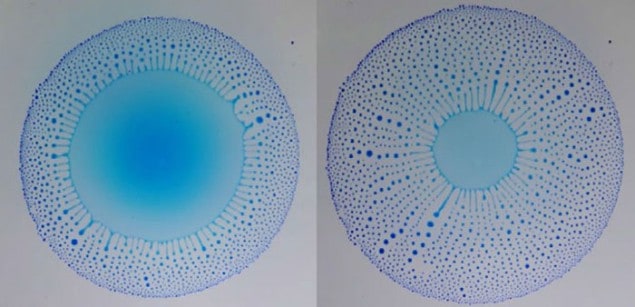Flash Physics is our daily pick of the latest need-to-know developments from the global physics community selected by Physics World‘s team of editors and reporters

Liquid drops explode
Drops of a water–alcohol mixture exploding into millions of tiny droplets have been observed by Etienne Reyssat and colleagues at the Institute of Industrial Physics and Chemistry in Paris. The explosions occur when the liquid is placed on a layer of oil and the physicists say that the process is driven by a combination of evaporation, surface tension and fluid flow. The relative concentrations of water and alcohol in the mixture determine the surface tension of the fluid – the more water, the greater the surface tension. When a high-alcohol mixture is placed on an oily surface, it will spread out to create a film, whereas a high-water mixture will form drops. However, as alcohol evaporates from the high-alcohol mixture, the increasing surface tension causes the liquid to form puddle-like drops. The rate of alcohol evaporation is greatest at the edge of the drops, causing fluid to flow rapidly towards the edge, where liquid bursts out creating thousands or even millions of droplets. The size of the ejected droplets can be adjusted from a few microns to a fraction of a millimetre by changing the ratio of alcohol to water in the mixture. The study is described in Physical Review Letters.
Award celebrates women for their pioneering research in developing countries

Five early-career researchers from developing countries have been honoured for their work in engineering sciences. The OWSD-Elsevier Foundation Awards for Early-Career Women Scientists in the Developing World celebrates the achievements of female researchers who have made a significant contribution to their field and encouraged young women in science in their respective countries. The 2017 winners are Tanzima Hashem of the University of Engineering and Technology in Bangladesh for her work developing computational methods to the protect privacy of people accessing location-based services; María Fernanda Rivera Velásquez of the Universidad Nacional de Chimborazo in Ecuador for her research on decontaminating industrial areas using native materials; Felycia Edi Soetaredjo of Widya Mandala Catholic University Surabaya in Indonesia for her work on using biomass for renewable energy and environmental decontamination applications; Grace Ofori-Sarpong of the University of Mines and Technology in Ghana for her work on extracting gold-bearing minerals and free particles from mine water; and Rania Mokhtar of Sudan University of Science and Technology in Sudan for her research into advanced security systems for mobile devices. The Elsevier Foundation award is run in partnership with The Academy of Sciences for the Developing World (TWAS) and the Organization for Women in Science for the Developing World (OWSD). The winners were rewarded $5000 each and an all-expenses-paid trip to the 2017 American Association for the Advancement of Science (AAAS) Annual Meeting in Boston, where they were honoured during a ceremony on 18 February.
Neutron star breaks X-ray emission record

A neutron star that emits X-rays at 1000 times greater intensity than predicted by theory has been discovered by astronomers working on the EXTraS X-ray observation programme. Located in NGC 5907 – a spiral galaxy 50m light-years from Earth, the ultraluminous X-ray source (ULX) is far too bright to be explained by the balance between the force of radiation acting outward on a neutron star and the gravitational force acting inward. This balance is called the “Eddington limit” and had led astronomers to assume that ULXs were driven by small black holes. Instead, observations using the XMM-Newton space telescope suggest that the X-rays are emitted by a spinning neutron star that is accelerating rapidly as it sucks in surrounding matter. While the intense X-ray emission cannot be explained if the star has a simple dipole magnetic field, the team writes in Science that the emissions could be driven by a magnetic field with strong multipolar components.
- You can find all our daily Flash Physics posts in the website’s news section, as well as on Twitter and Facebook using #FlashPhysics. Tune in to physicsworld.com later today to read today’s extensive news story on an atomic clock in a van.



